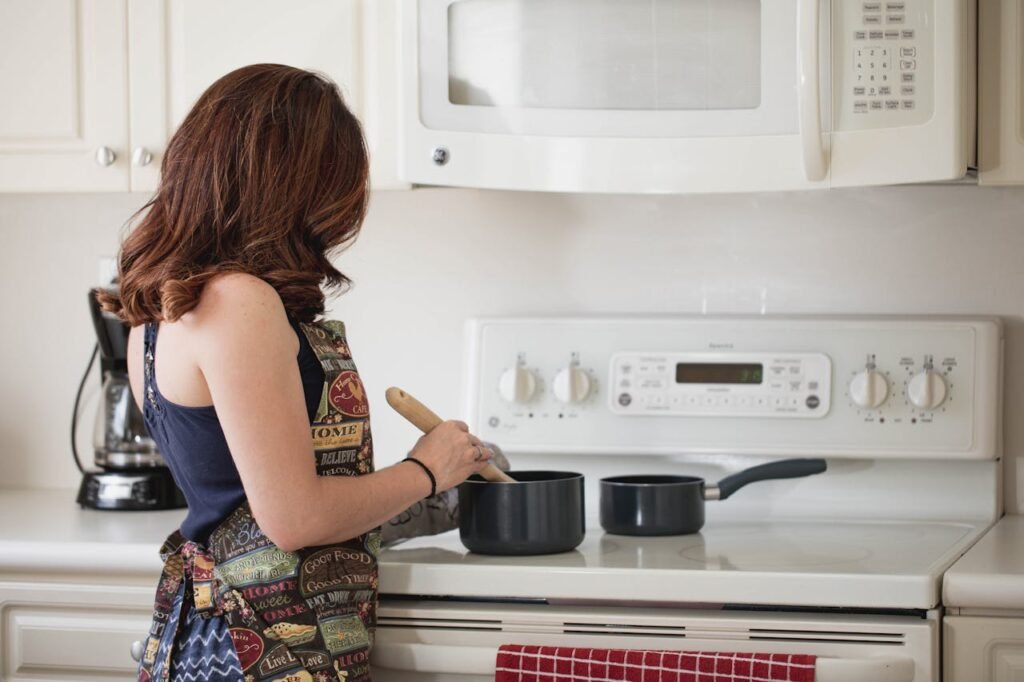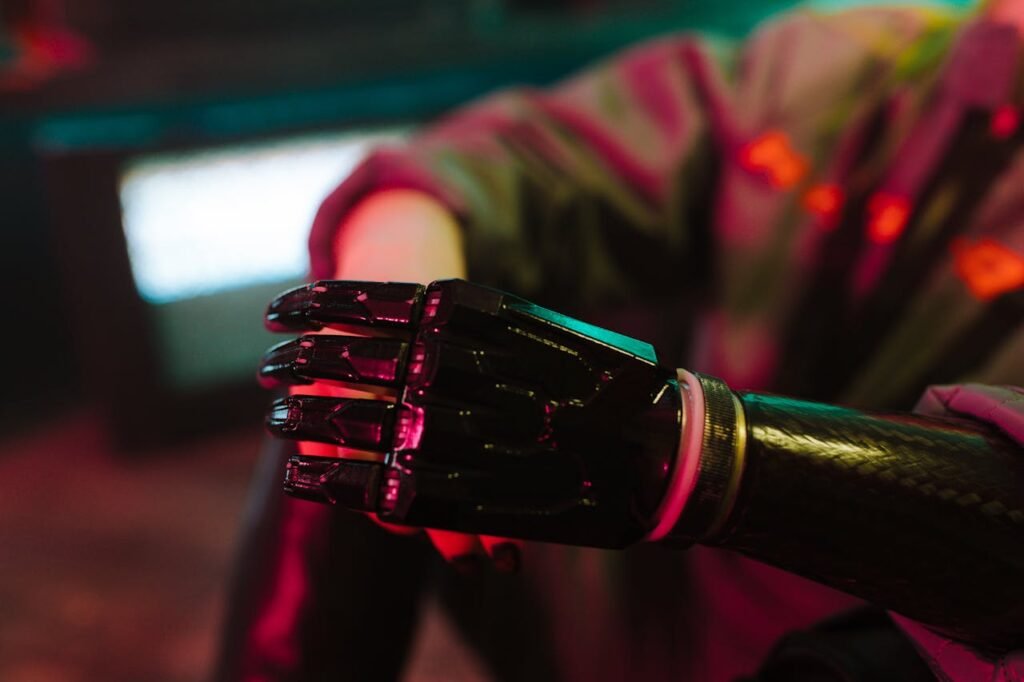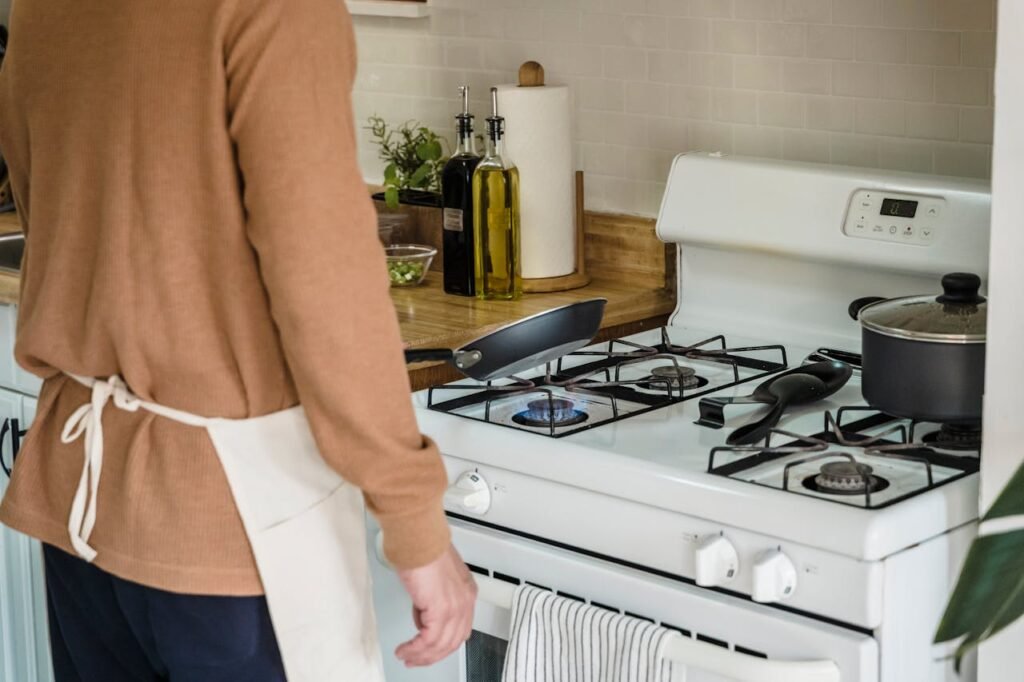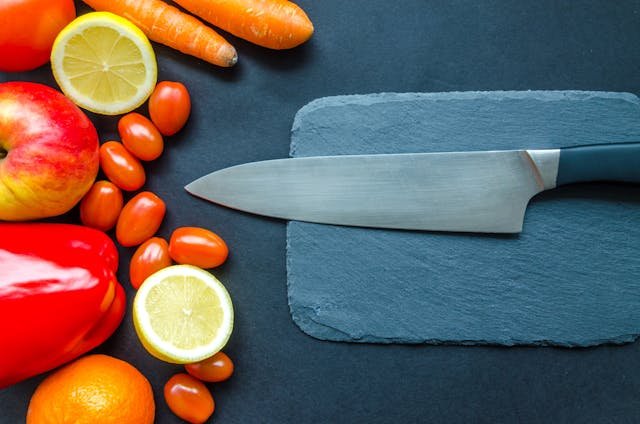Cooking is more than just preparing food. It’s love, warmth, and care served on a plate. For many of us, it’s a daily rhythm — chopping, stirring, tasting, and sharing meals with family. But for someone using a prosthetic hand, cooking can feel like stepping into new territory.
Suddenly, familiar tasks like flipping a roti or pouring oil demand new skills and confidence. You might wonder, “Can I still cook safely?” The answer is a simple, powerful yes.
Modern prosthetic hands — especially advanced ones like Grippy™ by RoboBionics — are designed to bring independence back to your kitchen. With the right tools, practice, and smart techniques, you can cook confidently, safely, and joyfully again.
This guide will walk you through every detail — from handling heat and managing oil splatters to gripping utensils and cutting vegetables safely. You’ll learn how to make your kitchen a friend, not a challenge.
Whether you’re a homemaker preparing family meals, a student living on your own, or someone rediscovering the joy of cooking after an amputation, this guide is for you.
Because cooking is not just about food — it’s about freedom, creativity, and the comfort of doing things your way.
Understanding Your Prosthetic Hand in the Kitchen
Getting Comfortable With Your Device

Before you cook, spend a few quiet minutes moving your prosthetic hand. Open and close the grip. Rotate the wrist. Notice the range, the speed, and the sweet spots where control feels smooth.
If your hand is myoelectric, contract the muscles you use for different grips. Hold that signal steady for three to five seconds. Release slowly. Repeat until your control feels calm and predictable.
If your hand is body-powered or passive, practice using it as a steady anchor. Learn how it supports bowls, traps fabric towels, or pins chopping boards without slipping.
This short warm-up builds trust. When your device feels familiar, the kitchen feels friendlier too.
Understanding Heat Limits
All prosthetic hands have heat limits. Direct flame, hot oil, and dry pans can damage outer covers and soften plastics. Keep your device away from open burners and the inner lip of hot pots.
Work slightly off the center of the stove. Use the back burners for boiling and the front for low-risk tasks like stirring cool sauces. This reduces heat exposure to the socket and the glove.
If you feel warmth on the shell, step back and pause. Heat travels through steam and metal handles faster than you think. Prevention is easier than repair.
Using Heat Shields and Covers
A simple cotton sleeve or silicone heat guard over the forearm can block splatter. For bionic hands, a removable, heat-resistant glove adds an extra barrier without affecting control.
Choose materials that tolerate at least moderate kitchen heat and clean up easily. Avoid bulky layers that reduce dexterity or snag on pan handles.
Keep a spare protective cover near the stove. If one gets wet or greasy, swap it out at once. Dry protection works better and lasts longer.
Oil Splatters and Safe Distance
Oil pops when moisture hits a hot surface. Keep an extra few inches between the pan and your prosthetic hand during the first minute of frying. That’s when splatter is worst.
Use long-handled spatulas and tongs to increase reach. Angle the pan lid slightly to create a shield while steam escapes away from you.
Lower food into oil gently. Slide it down the side of the pan instead of dropping it in. Gentle placement means gentle splatter.
Managing Steam Safely
Steam burns fast because it wraps around surfaces. When lifting a lid, tip the far edge first so vapour moves away from your arm and socket.
Stand slightly to the side of the pot. Keep your prosthetic hand behind the path of steam. Move slowly until the boil settles.
Wipe condensation from the counter at once. Wet surfaces make bowls slide, and sliding bowls demand stronger grips.
Grip Patterns That Help
Think in three grips: pinch, power, and cradle. Pinch for packets and spice jars. Power for pans, pestles, and heavy lids. Cradle for bowls and plates that need gentle support.
Practice switching grips without looking at your hand. Feel the pressure build through your muscle signals or cable tension. Stop just before the maximum force. That point is where control lives.
With Grippy-style tactile feedback, learn the sensation of a safe hold. Light pressure for tomatoes. Firm pressure for a kadai handle. Your hand will remember.
Force Control With Delicate Foods
Soft foods tear easily. When holding bread, idli, or ripe fruit, think “place and support,” not “squeeze and lift.” Use your prosthetic hand to steady, and let your sound hand perform the fine action.
For slippery items like onions or tomatoes, anchor the cutting board with the prosthesis, then slice with your natural hand. Stability is half the job.
If you must hold and cut with the prosthesis, use a non-slip glove on the food side or place a textured mat between food and hand. Friction reduces the force you need.
Wrist Position and Joint Safety
Neutral wrist angles protect both your device and your shoulder. When stirring, keep the wrist straight and use your body to create the circle. Your core provides power; your hand guides.
If your wrist rotates, set a comfortable angle before reaching over heat. Lock that position for the task, then unlock once you move away from the stove.
Short tasks deserve short holds. Rest the arm between steps so motors and cables cool down and your muscles relax.
Socket Comfort During Cooking
Heat and humidity can build under the socket. A breathable liner helps manage sweat and reduces skin friction. Keep a clean towel nearby to dry the limb during breaks.
If the socket feels loose after sweating, pause, dry, and reseat. A snug socket improves control and cuts down on accidental knocks.
Check your skin after longer cooking sessions. Red spots that don’t fade may signal pressure points that need adjustment.
Planning Your Kitchen Layout
Bring your work closer. Place chopping boards next to the stove, but not directly over heat. Keep salt, oil, and ladles within an easy sweep of your sound arm.
Store heavy pots at waist height. Lifting from low drawers strains your back and makes you overreach with the prosthesis.
Use shallow trays to carry ingredients from counter to stove. A tray spreads weight, so your hold can be lighter and steadier.
Creating Safe Zones
Mark a “hot zone” around each burner. Your prosthetic hand avoids this circle unless you’re holding a long tool.
Set a “wet zone” near the sink. Only drip-safe tools go there. Keep electronics, chargers, and battery packs far from this area.
Have a “cool zone” for plating. Once food lands there, no more heat, no more splatter — just calm finishing work.
Tool Choices That Make Life Easier
Long tongs, wide spatulas, and ladles with deep bowls reduce effort. Choose silicone or wood for gentle contact and less heat conduction.
Look for handles with rubberized grips. A soft, textured surface needs less force to hold. Your muscles will thank you.
If a tool feels awkward, bendable-neck versions let you set the angle that suits your wrist and shoulder. Small changes, big comfort.
Cutting Boards and Stability
A sturdy board is the quiet hero of kitchen safety. Add a non-slip mat underneath to keep it from creeping.
Use your prosthetic hand to pin the board at a corner, not the center. This leaves space for your knife and keeps the board flat.
For round foods, make a small flat side first. Rest that flat side down. Stability turns tricky cuts into easy ones.
Pans, Pots, and Lids
Choose lighter cookware with balanced handles. A lighter pan means a softer grip. Balanced weight means fewer slips.
Use two-point control for hot pans: prosthetic hand on the long handle, natural hand guiding a helper grip or the pan rim with a mitt. Move slowly and close to the counter.
Keep lid knobs dry. A wet knob needs more pressure, and more pressure increases risk. Quick towel, safer hold.
Stirring, Flipping, and Plating
When stirring thick food, use gentle, repeated arcs rather than hard circles. Let the pot’s edge support the tool.
For flipping, slide the spatula under the food completely, then lift just a little. Bring the pan toward the spatula rather than reaching far across heat.
During plating, place the dish close to the pan. Transfer in small portions. Small scoops give you more control and fewer spills.
Managing Electric Appliances
Blenders, mixers, and air fryers are helpful partners. Place them where cords won’t cross your working arm. Secure the base with your prosthesis while the other hand handles controls.
Use pulse settings for better control. Short bursts prevent splashes and keep lids from jumping.
Unplug before cleaning. Wipe with a damp cloth, never a dripping one. Keep moisture away from your device and the socket.
Handling Spices, Bottles, and Packets
Spice jars can be tiny and stubborn. Trap the jar body with your prosthesis and twist the lid with your natural hand. If lids slip, wrap a rubber band around them for extra grip.
Cut open packets while they rest on the counter. Hold the packet corner with the prosthesis and snip with scissors in your natural hand. No mid-air cutting, no sudden tears.
Pour slowly from small containers. A steady angle makes less mess and keeps handles clean for the next step.
Cleaning As You Go
Wipe spills at once. Oil on the counter multiplies risk because tools and bowls begin to slide.
Use warm water and mild soap to clean your protective glove or shell after cooking. Dry fully before storing. Moist covers wear faster and hold smells.
If food splashes onto the socket, remove the device when safe, clean the area gently, and allow the liner to air-dry. Clean gear works better and lasts longer.
Practicing With Cold Runs
Before trying a hot dish, run a cold rehearsal. Practice the motions of stirring, flipping, and lifting with an empty pan and a cool stove.
Drill the sequence: reach, grip, move, place, release. Repeat until the path feels smooth and natural. Then cook for real.
Rehearsal builds memory. Memory builds safety. Safety builds joy.
Working With Children and Family Around
Set clear boundaries when others are in the kitchen. Mark a “no-entry” line near the stove during frying or draining.
Ask for help with tasks that create sudden heat, like tempering hot oil. You control the pace; others fit around your rhythm.
Cooking together is still love. Safety just gives it gentle rules.
Choosing Recipes While You Learn
Start with meals that use one pan and steady heat. Upma, dal, sautéed vegetables, scrambled eggs, or simple tadkas build confidence.
As control grows, add steps: boiling pasta while simmering sauce, or flipping dosas while tempering mustard seeds.
Complex recipes are just simple steps in a longer line. Master the steps, and the line becomes easy.
When Something Goes Wrong
If oil smokes, turn the heat off first. Then step back. If a small flame appears in a pan, cover it with a lid. Never pour water on hot oil.
If a tool slips, let it fall. Do not lunge over heat to catch it. Safety beats saving a spoon every single time.
If your hand feels hot, stop. Cool down, check covers, and continue only when you feel secure.
Caring For Your Device After Cooking
Wipe the outer glove with a damp cloth and mild soap. Rinse the cloth and wipe again to remove residue. Dry with a soft towel.
Inspect moving joints for food particles. A soft brush helps clear crumbs without forcing debris into hinges.
Recharge batteries away from steam and heat. Store the hand in a cool, dry spot, ready for tomorrow.
Building Calm Through Breathing
Cooking asks for focus. When you start to rush, pause for three breaths. In through the nose. Out through the mouth. Shoulders down.
This resets your control signals and steadies your grip. Calm breath, calm hands, safe cooking.
Growing Confidence With Grippy-Style Feedback
If your prosthesis offers tactile feedback, use it as your kitchen guide. Learn the feel of safe pressure on a pan handle, a jar lid, or a metal spoon.
Train with simple drills: hold a paper cup without crushing it, then a ceramic mug without slipping it. Your sense of force will sharpen quickly.
Better feel means lighter holds, and lighter holds mean less fatigue. That’s how long cooking sessions stay enjoyable.
Adapting Traditional Indian Techniques
For tadka, keep the pan at arm’s length and add spices with a long spoon. After the sputter, move closer to stir.
When rolling rotis, anchor the board with your prosthetic hand and roll with the other. Rotate the dough with small nudges, not big swings.
For pressure cookers, release steam fully before opening. Angle the lid so vapour moves away from your prosthesis and face.
Small Habits That Change Everything
Keep a dry cloth on your shoulder for quick wipes. Place tools back in the same spot every time. Turn pot handles inward yet reachable.
Announce hot moves out loud if others are nearby. “Hot pan moving left.” Your voice becomes an extra safety tool.
End every session with a five-minute reset: wipe, wash, dry, and set things back. Tomorrow’s you will be grateful.
Understanding Your Prosthetic Hand in the Kitchen
Getting Comfortable

Before cooking, move your prosthetic hand around for a minute. Open, close, rotate, and test your grip. Feel how strong it is and how far it moves. This helps you control it better once the heat is on.
If you use a bionic hand like Grippy™, try short muscle signals for small grips and longer ones for bigger actions. If it’s a body-powered hand, test how the cable responds to shoulder movement.
The goal is to get familiar and relaxed.
Staying Safe Around Heat
Keep your prosthesis away from direct flames and very hot pans. Heat can damage the glove or the outer shell. Use back burners for boiling and cook from the side when frying.
If you feel warmth through your socket, take a short break. Small precautions keep your prosthesis safe and working well.
Handling Oil and Steam
Hot oil and steam can be tricky. Always use long-handled spoons or tongs. Slide food gently into oil instead of dropping it.
When opening lids, tilt them so steam goes away from your face and hand. These habits prevent quick burns or splashes.
Simple Grip Tips
Use three grips: light pinch for jars, firm grip for utensils, and gentle cradle for plates. Don’t squeeze too tightly — it makes things slip.
If your prosthesis has feedback, learn how much pressure is just right. Practice with soft and hard objects to understand grip levels.
Clothing and Comfort
Wear cotton sleeves or a heat-resistant glove on your prosthesis when cooking. It protects from splatters and oil. Avoid loose clothes that can brush over the flame.
Keep a towel handy to dry sweat around the socket. A dry fit gives better control.
Organizing Your Kitchen
Keep what you use most — oil, salt, ladles — close to your main arm. Put heavy pans at waist height. Avoid bending or stretching too much.
Use one side of the counter as your safe zone for chopping and mixing. It keeps things simple and predictable.
Cooking Tools That Help
Use light, balanced pans and silicone-handled spoons. They don’t heat up quickly and are easy to grip.
Non-slip mats under bowls and cutting boards stop sliding. Wooden spoons and spatulas are better than metal for stirring hot food.
Cutting and Chopping
Hold the board steady with your prosthesis and slice with your natural hand. For small veggies, cut them in half first so they don’t roll.
Use a wide knife and keep motions slow. Sharp blades need less pressure and are actually safer.
Cleaning and Maintenance
After cooking, wipe your prosthetic glove or cover with a damp cloth and dry it completely. Don’t leave moisture near the joints or battery.
If food or oil splashes on your socket, clean it gently with a soft towel and mild soap. Keep it dry before wearing again.
Practicing Cool Runs
Before using heat, practice actions like stirring or flipping in a cold pan. Once it feels easy, try it with real food. Small practice sessions build confidence and memory.
Quick Safety Reminders
Never reach over a flame. Don’t chase falling tools — let them drop. Keep your prosthesis dry and cool.
If oil smokes, turn the stove off first. Cover small fires with a lid, never water. Calm, steady actions keep you safe.
Cooking Techniques and Heat Control with a Prosthetic Hand
Starting Slow

Cooking with a prosthetic hand gets easier when you start small. Try simple dishes first — boiling rice, making tea, or sautéing vegetables. These steps teach your hand balance and timing.
Once you feel steady, move on to frying or multitasking at the stove. Progress naturally; there’s no rush.
Managing Heat
Always cook on medium flame. High heat causes quick splatter and can damage your prosthesis. If you need more heat, step back slightly and use long tools.
When working with oil, heat it slowly. Sudden temperature jumps make food pop and spill. Slow, steady cooking is both safer and tastier.
Position at the Stove
Stand at an angle, not directly in front of the burner. Keep your prosthetic side slightly away from heat. This protects the glove and socket from steam and splashes.
Keep pot handles turned inward but reachable. That way, you don’t accidentally knock them over.
Holding Utensils
If your prosthesis has an adjustable grip, find a gentle hold for spoons and spatulas. Too tight and you’ll struggle to move; too loose and the tool may slip.
Test your grip before you start cooking. Lift the utensil, twist your wrist slightly, and make sure it feels secure. Once it does, you’re ready.
Stirring and Mixing
When stirring, let your prosthetic hand guide while your body does the motion. Move from your shoulder, not your wrist. It keeps things natural and balanced.
For thicker dishes like curries or dough, use your prosthesis to hold the pot steady while stirring with your natural hand. You’ll get more control that way.
Flipping and Turning Food
Flipping rotis, pancakes, or cutlets needs timing more than strength. Slide the spatula under gently and lift only enough to turn.
Keep the pan close to you, not far away. Bring the food to your hand — not your hand to the heat.
If something sticks, turn off the stove before adjusting. Safety always comes first.
Lifting Hot Pans
When moving hot pans, hold them near your waist, not chest height. This gives you better balance and avoids spills.
If your prosthesis is holding one side, let your natural hand guide the other. Move slowly and stay close to the counter — not across long distances.
Avoid heavy iron pans if possible. Lightweight ones with firm handles are easier to control and safer to grip.
Managing Steam and Boiling Water
Steam burns faster than flames. When lifting a pot lid, open it away from your body and your prosthetic side.
When draining pasta or rice, rest the strainer in the sink first. Then pour the water slowly using both hands. Stability is key.
Keep a dry towel nearby to wipe handles before you grab them. Wet handles cause slips.
Using Appliances
Small kitchen gadgets make cooking simpler. Electric kettles, rice cookers, and sandwich toasters reduce stove time and risk.
When using mixers or blenders, keep them at counter level. Hold the base with your prosthesis and press buttons with your natural hand.
Always unplug before cleaning. Even a small splash of water can be dangerous near wires.
Working With Oil
Hot oil is one of the biggest fears for new users — but it’s manageable. Keep your prosthesis slightly behind the pan.
Add food with your other hand, or use tongs with long handles. Drop items slowly, not from above. This keeps splashes low.
If oil pops, take a small step back. Wait a few seconds before approaching again.
After frying, let oil cool before moving the pan. Never pour hot oil into containers right away.
Cooking One-Handed Tricks
Even if your prosthesis doesn’t move, it’s still useful. Use it to hold cutting boards, bowls, or pans in place while your natural hand does the active work.
If you need to stir or mix something thick, hold the bowl with your prosthetic hand pressed gently against your stomach for extra support. It keeps things steady without much effort.
Grip Adjustments
Every food texture feels different. Smooth surfaces like steel need stronger grip; soft ones like plastic bowls need lighter touch.
Practice with utensils of different sizes. Learn the pressure needed for each. It helps you react naturally when cooking.
If your prosthesis has a rotating wrist, angle it slightly before gripping. It saves strain on your shoulder.
Balancing Movements
Cooking isn’t about arm strength — it’s about rhythm. Alternate between both hands. Let your prosthetic hand anchor while your other hand moves.
Small breaks matter. After 20–30 minutes, rest your arm for a few seconds. It prevents tiredness and improves accuracy.
Spices and Jars
Spices often come in small containers that are hard to open. Grip the jar with your prosthesis and twist the lid with your natural hand. Rubber grips or cloth around the jar help with friction.
If a jar is stuck, tap the lid gently or use a spoon edge to lift the seal. Avoid forcing the grip — it can damage your prosthesis over time.
For measuring, place the spoon on the counter, hold it steady with your prosthesis, and scoop with your other hand. No spills, no stress.
Taste and Texture
You may cook slightly slower than before, but that’s okay. Slow cooking often brings out better flavors.
Taste as you go, adjust seasoning calmly, and take pride in your control. Every small step in the kitchen is part of rebuilding your independence.
Staying Calm During Mistakes
Everyone makes mistakes while cooking — prosthetic or not. A burnt roti or spilled curry isn’t a failure. It’s part of learning your rhythm again.
When things go wrong, switch off the stove first, then fix the issue. There’s always time to clean or start over.
Cooking safely means cooking without hurry.
Cleaning Up
When you’re done, let everything cool before washing. Use your prosthesis to steady dishes while your other hand cleans.
A non-slip mat in the sink keeps plates from sliding. Wash one thing at a time and rinse slowly.
Dry your prosthesis and glove if they get wet. A clean device lasts longer and performs better.
Confidence Over Time
At first, you’ll focus on every small move — how to stir, how to grip, how to reach. But soon it will all become natural.
Cooking daily, even for a few minutes, builds skill and comfort. In a few weeks, you’ll move through recipes without thinking about the steps.
Your prosthetic hand will stop feeling like a tool. It will feel like a part of you again — steady, capable, and confident.
Kitchen Setup, Practical Safety Tips, and Confidence in Cooking with a Prosthesis
Setting Up Your Space

Keep your main work area close to the stove but not over heat. Place a chopping board, a small bowl for scraps, and a dry towel within easy reach.
Store heavy pots at waist height. Avoid deep lower cabinets and high shelves that force long reaches or awkward lifts.
Clear the counter before you start. A clean surface gives you room to move and keeps your rhythm calm.
Safe Workstation Basics
Stand slightly side-on to the stove. Keep your prosthetic side a little farther from heat and steam.
Use a rubber mat under the board and bowls. Non-slip support means lighter grip and fewer slips.
Keep handles dry. Wipe as you go so your hold stays steady, even during busy steps.
Smart Tool Placement
Place oil, salt, and ladles on your natural-hand side. Keep tongs and a wide spatula near the stove.
Set a heatproof trivet next to the burner. Hot pans move onto the trivet, not the bare counter.
Return tools to the same spot every time. Muscle memory saves effort and time.
Lighting and Ventilation
Good light reduces mistakes. Use bright task lighting over the counter and stove.
Run the exhaust fan during frying and boiling. Steam and smoke make grips uncertain and eyes watery.
Open a window for airflow. Cooler air keeps your socket comfortable.
Ingredient Prep That Helps
Prep cool and calm. Rinse, peel, and chop before heat. Place items in small bowls so you can add them without rushing.
Anchor the board with your prosthesis and slice with your natural hand. For rolling foods, make a flat side first.
Measure spices on the counter. Hold the spoon steady with your prosthesis and scoop gently.
Heat Management Zones
Create three zones: hot by the burners, warm near the trivet, and cool by the plating area.
Move food through these zones in order. This keeps you away from sudden heat and splatter.
Teach family members these zones too. Shared rules keep everyone safe.
Utensils That Work With You
Choose light pans with firm, rubberized handles. They ask for less force and hold better.
Use long tongs, wide spatulas, and silicone ladles. Length adds distance; width adds control.
Try bendable-neck tools if wrist angles feel tight. Small tweaks reduce strain a lot.
Appliance Strategy
Let appliances handle risk. A rice cooker, kettle, or air fryer cuts time at the stove.
Keep devices on a dry, open counter. Hold the base with your prosthesis and use buttons with your other hand.
Unplug before cleaning. Wipe, dry, and coil cords neatly.
Simple Cleanup Flow
Let pans cool. Scrape, soak, then wash one by one. Use a non-slip mat in the sink.
Dry your prosthetic glove or cover if it gets wet. Moisture weakens grip and shortens life.
Reset the kitchen: tools back, counters wiped, floor dry. Tomorrow starts easier.
Wearing Protection Wisely
A thin cotton sleeve or heat-resistant glove over the prosthesis guards against splatter.
Avoid loose cuffs near flames. Keep fabric close to the arm without dangling ends.
Change any wet cover quickly. Dry protection works better and feels safer.
Quick Frying Routine
Heat oil slowly on medium. Slide food down the pan’s side with tongs.
Stand a step back for the first minute. Angle a lid to shield splatter while steam escapes.
When done, let the pan rest on a trivet. Cool before you pour.
Simple Boiling Routine
Set the pot on the back burner. Keep handles inward but reachable.
Open lids away from your face and prosthetic side. Pour into a strainer resting in the sink, not held mid-air.
Wipe drops on the floor at once. Wet floors cause sudden slips.
Confidence Builders
Practice cold runs: stir in a cool pan, flip a dry roti, pour water from a light pot. Rehearsal builds memory.
Cook one easy dish daily. Short, steady sessions train grip and timing without fatigue.
Add one new step each week: gentle frying, two-pot cooking, thicker batters. Grow slowly and win often.
Working With Family
Tell others when you’re moving a hot pan. A simple “hot pan right” clears the path.
Ask for help on risky steps early on. Watch, learn, then try the same step next time.
Set shared rules: no running near the stove, handles turned in, spills wiped fast.
Small Troubleshooting Moves
If a tool slips, let it drop. Don’t reach over heat.
If oil smokes, turn off the flame first. Cover the pan to calm it.
If your socket gets sweaty, pause and dry. A snug, dry fit gives clean control.
Caring for Your Prosthesis
After cooking, wipe the glove with mild soap and a damp cloth. Dry with a soft towel.
Check joints for crumbs and wipe the wrist area clean. Keep batteries away from steam and heat.
If you notice hot spots on the shell, review your stove distance and tool length next time.
Mindset That Lasts
Cook at your pace. Calm beats quick. Safe beats bold.
Notice the wins: a neat flip, a quiet pour, a steady stir. These moments build real confidence.
Your prosthesis isn’t a limit. It’s a partner you train, one meal at a time.
Conclusion and Next Steps
Your Kitchen, Your Rules
You decide the pace, the tools, and the path from prep to plate. Simple steps, steady practice, and smart layouts make cooking safe and enjoyable.
With each session, your control improves. What felt careful becomes natural. What felt slow becomes smooth.
The kitchen becomes your space again — warm, welcoming, and fully yours.
Start Today, Grow Tomorrow
Begin with one easy dish. Keep heat moderate, tools close, and movements slow.
Add new skills bit by bit: longer tongs, steady pouring, confident flipping. The rhythm builds quietly, then stays.
Small progress every day turns into full independence.
We’re Here To Help
At RoboBionics, we design hands like Grippy to feel natural and safe in daily life — including the kitchen.
If you want personal tips, fittings, or training ideas, we’re ready to guide you. Book a demo at robobionics.in/bookdemo and see how the right setup changes everything.



